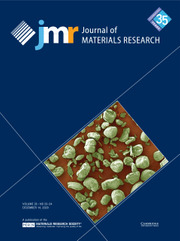Crossref Citations
This article has been cited by the following publications. This list is generated based on data provided by
Crossref.
Morawski, A.W.
Kalenczuk, R.
and
Inagaki, M.
2000.
Adsoption of trihalomethanes (THMs) onto carbon spheres.
Desalination,
Vol. 130,
Issue. 2,
p.
107.
2000.
New Carbons - Control of Structure and Functions.
p.
218.
Inagaki, M
Bourelle, E
Vignal, V
Konno, H
and
Morawski, A.W
2001.
Creation of nano-sized spaces in carbon materials by oxidation and their characterization under STM.
Synthetic Metals,
Vol. 125,
Issue. 2,
p.
231.
Serp, Ph.
Feurer, R.
Kalck, Ph.
Kihn, Y.
Faria, J.L.
and
Figueiredo, J.L.
2001.
A chemical vapour deposition process for the production of carbon nanospheres.
Carbon,
Vol. 39,
Issue. 4,
p.
621.
Bourelle, E
Kaburagi, Y
Hishiyama, Y
and
Inagaki, M
2001.
STM study of surfaces of kish graphite doped by iron.
Carbon,
Vol. 39,
Issue. 13,
p.
1955.
Kim, Myung Il
Yun, Chang Hun
Kim, Young Jeon
Park, Chong Rae
and
Inagaki, Michio
2002.
Changes in pore properties of phenol formaldehyde-based carbon with carbonization and oxidation conditions.
Carbon,
Vol. 40,
Issue. 11,
p.
2003.
Przepiórski, Jacek
Tryba, Beata
and
Morawski, Antoni W
2002.
Adsorption of carbon dioxide on phenolic resin-based carbon spheres.
Applied Surface Science,
Vol. 196,
Issue. 1-4,
p.
296.
Inagaki, Michio
and
Sakanishi, Midori
2003.
Adsorption of Organic Molecules in Water onto Carbon Spheres Nanostructured by Air Oxidation.
Adsorption Science & Technology,
Vol. 21,
Issue. 6,
p.
587.
Paredes, J.I
Martı́nez-Alonso, A
and
Tascón, J.M.D
2003.
Application of scanning tunneling and atomic force microscopies to the characterization of microporous and mesoporous materials.
Microporous and Mesoporous Materials,
Vol. 65,
Issue. 2-3,
p.
93.
Kim, Young Jeon
Kim, Myung Il
Yun, Chang Hun
Chang, Ji Young
Park, Chong Rae
and
Inagaki, Michio
2004.
Comparative study of carbon dioxide and nitrogen atmospheric effects on the chemical structure changes during pyrolysis of phenol–formaldehyde spheres.
Journal of Colloid and Interface Science,
Vol. 274,
Issue. 2,
p.
555.
Kamikawa, Hideya
Hibi, Keita
Mizoguchi, Kensaku
Matsui, Shigetoshi
and
Murakami, Kenji
2006.
Structural Control of Micro-Pore Surface and Trihalomethanes Adsorption Ability of Phenol Activated Carbon.
JOURNAL OF CHEMICAL ENGINEERING OF JAPAN,
Vol. 39,
Issue. 12,
p.
1276.
Inagaki, M.
and
Tascón, J.M.D.
2006.
Activated Carbon Surfaces in Environmental Remediation.
Vol. 7,
Issue. ,
p.
49.
Wang, Lihong
Fujita, Masahito
and
Inagaki, Michio
2006.
Relationship between pore surface areas and electric double layer capacitance in non-aqueous electrolytes for air-oxidized carbon spheres.
Electrochimica Acta,
Vol. 51,
Issue. 19,
p.
4096.
Hua, Zhong
Zhong, Ya Juan
and
Li, Dong Feng
2007.
Pores in PAN-Based Carbon Fiber and Effects of Pore Defects on Mechanical Properties.
Materials Science Forum,
Vol. 546-549,
Issue. ,
p.
1665.
Dong, Yong-Rong
Nishiyama, Norikazu
Egashira, Yasuyuki
and
Ueyama, Korekazu
2008.
Basic Amid Acid-Assisted Synthesis of Resorcinol−Formaldehyde Polymer and Carbon Nanospheres.
Industrial & Engineering Chemistry Research,
Vol. 47,
Issue. 14,
p.
4712.
Inagaki, Michio
Park, Chong-Rae
Skowronski, Jan M.
and
Morawski, Antoni W.
2008.
Glass-Like Carbon Spheres — Activation, Porosity and Application Possibilities.
Adsorption Science & Technology,
Vol. 26,
Issue. 10,
p.
735.
Zheng, Mingtao
Liu, Yingliang
Xiao, Yong
Zhu, Yong
Guan, Qiu
Yuan, Dingsheng
and
Zhang, Jingxian
2009.
An Easy Catalyst-Free Hydrothermal Method to Prepare Monodisperse Carbon Microspheres on a Large Scale.
The Journal of Physical Chemistry C,
Vol. 113,
Issue. 19,
p.
8455.
Harris, A.T.
Deshpande, S.
and
Kefeng, X.
2009.
Synthesis of graphitic carbon particle chains at low temperatures under microwave irradiation.
Materials Letters,
Vol. 63,
Issue. 16,
p.
1390.
Mhlanga, S.D.
Coville, N.J.
Iyuke, S.E.
Afolabi, A.S.
Abdulkareem, A.S.
and
Kunjuzwa, N.
2010.
Controlled syntheses of carbon spheres in a swirled floating catalytic chemical vapour deposition vertical reactor.
Journal of Experimental Nanoscience,
Vol. 5,
Issue. 1,
p.
40.
Lian, Suoyuan
Ming, Hai
Huang, Hui
Kang, Zhenhui
and
Liu, Yang
2012.
Carbon microspheres from ethanol at low temperature: Fabrication, characterization and their use as an electrocatalyst support for methanol oxidation.
Materials Research Bulletin,
Vol. 47,
Issue. 11,
p.
3336.

